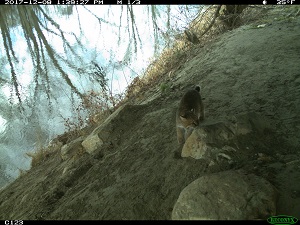
BRANDON, Vt. – This bobcat was caught in a series of photos on a game camera set up under a bridge in Brandon, Vermont. The cameras are put out as part of a collaborative partnership between Vermont Fish & Wildlife, The Nature Conservancy, and VTrans to better understand wildlife movement around road crossing structures.
“This bobcat passing under the road highlights the fact that wildlife are always on the move,” said John Austin, Vermont Fish & Wildlife’s lands and habitat program manager. “They need to travel across the landscape to find food or water, to search for mates, or to find places to den or raise their young. Maintaining healthy and connected habitats is one of the most important things we can do to help wildlife continue to thrive in Vermont.”
Information learned through this collaborative partnership has allowed VTrans to modify the design of bridges, culverts, and overpasses to permit improved movement of fish and wildlife, while also making these crossings safer for drivers on the road. Additionally, these modifications often help these structures to become more resilient to flooding events.
“We have thousands of photos of wildlife using these structures to safely move from one side of the road to the other, including shots of moose, bear, and deer, as well as several other bobcat photos. But rarely do we get such a fascinating glimpse into the behavior of an animal as it’s passing in front of the camera,” said Austin.
Improving road crossings is one part of a larger effort of the Vermont Fish & Wildlife Department to use science to sustain healthy habitats for wildlife across the state, referred to as Vermont Conservation Design. Other aspects of Vermont Conservation Design help protect Vermont’s forests from over-development, maintain clean air and water, and support the social and economic benefits of the state’s healthy fish and wildlife.
For Immediate Release: May 23, 2018
Media Contacts: Jens Hilke 802-999-7792; John Austin, 802-476-0797
